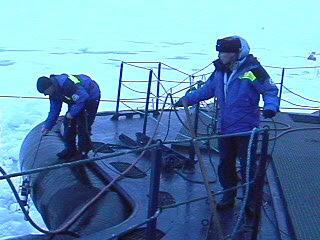
|
|
9 August, 2001
Lab Day
Thursday, 9 August 2001
Valkommen!
Life on Board
At about 9 pm, a very large, very fat bear approached the ship from upwind
to within about 1 kilometer and everybody headed up to the bridge or out on
Deck 4 to see what it would do next. These bears fascinate everybody, even
if they are a kilometer away. Our security people believe that it came up
the scent trail of the ship, possibly from hundreds of kilometers away, and
circled around to upwind to check us out. There must be some pretty
interesting smells and sounds coming from this place: diesel, solvents,
chemicals, breakfast, lunch, dinner, people, beeping Doppler acoustic radar,
rumbling engines. It stayed at that distance, walking around, laying down,
sniffing the air, sitting down with its back to us. It lounged on top of a
small ice ridge for a long time, facing us, one foreleg bent around in front
of it like it was leaning against a bar. People lost interest after awhile
and drifted away. I guess the bear lost interest after awhile, too, and
drifted away.
Where Are We Now?
The wind changed direction and was blowing from behind the ship so at about
10 am, the crew had to turn the ship around 180 degrees. This is necessary
for air sampling on the foredeck but a hassle for everyone because they
disconnect all the power to the ice camps and pull up the gangway for a few
hours. I needed to run up to my container from the aft deck to make sure my
computer and cameras were tied down because the ship must icebreak a little
to turn around. People in the labs need to make sure everything is secured
also. What is always interesting is that they only give us about 15 minutes
warning every time this happens. Coordinates on this cloudy day were 88o35'
North by 3o48' East at 7 pm.
Scientists at Work
Twice a week, we have intensive sampling days where everybody in the
atmospheric chemistry group takes data and samples all day, if they can.
Then they use the days in between to analyze their data and prepare graphs
to share at the next meeting. At 8 am, my small Bigelow lab group heads out
to the aft deck to lower the chlorophyll fluorometer (from Biospherical
Instruments) down to 100 meters by hand. This gives Patricia Matrai
information about where the plankton are most likely to be found in the
water column, so she watches the incoming data on the computer screen as
Brian Thompson and I lower the instrument. Then at 9 am the big
CTD/sampling rosette is lowered. From this, we take seawater samples from
100, 50, 30, 20, 10, and 5 meters depth, and a surface sample.
The Biogeochemical Group has drilled a hole through the ice out at their ice
camp and put up a tent around it. They have equipment inside their tent
(and a snowman outside their tent) and they can pump water up from any
depth. Our group asked them to get samples from the same seven depths at
the same time we were sampling from the open water lead (so I had twice the
normal number of samples to process today). The scientists want to see how
the biology and chemistry under the ice differs from the open lead where the
ship is sitting.
Vi ses! (See you later!)
From Deck 4 on the Icebreaker Oden, drifting randomly, northeast of 88,
Dena Rosenberger

Brian and I lowering the chlorophyll fluorometer from the aft deck (Don't worry Mom, we are safety harnassed to the ship)
Contact the TEA in the field at
.
If you cannot connect through your browser, copy the
TEA's e-mail address in the "To:" line of
your favorite e-mail package.
|
